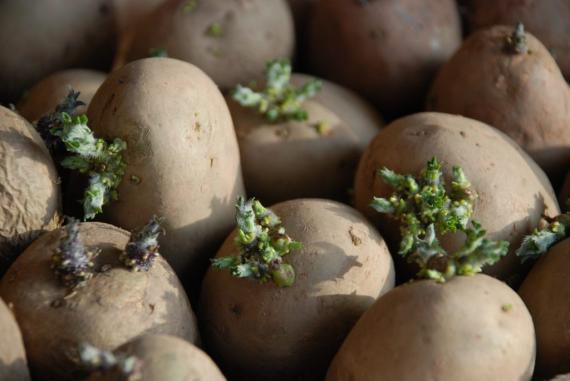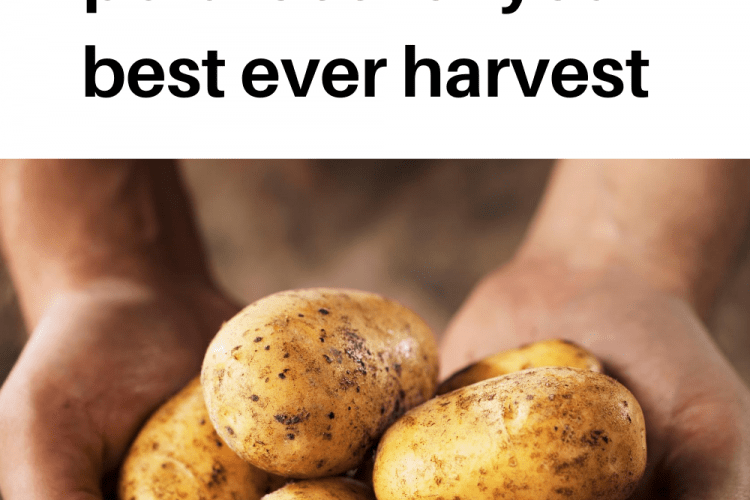I love growing potatoes, you plant them and then a few weeks later you are rewarded with bountiful of potatoes. So that’s what I am going to show you how to get your own delicious new potatoes.
I remember when I was little how my grandma would cook the potatoes that grandad had just dug out of their garden in the morning. The delicious smell and the taste. No shop-bought potatoes taste the same as homegrown potatoes.
Often people ask me what type of potato should they grow, earlies, second earlies, or main-crop.
First early also known as ‘new’ potatoes produce their crop the earliest usually in June.
Second earlies are also known ‘new’ potatoes) take a little longer to mature and are usually ready to eat in July.
Both of these earlies are expensive in the shops, they are also the most popular to grow.
Main-crop potatoes take longer to mature and are harvested from the end of August/September. Main-crop potatoes can be baked, roasted, and mashed, and they can be stored for many months.
It really depends on how much space you have. But I would recommend planting some earlies and second earlies. They take up less room and you have less chance of potato blight because they are harvested before potato blight takes hold.
But if you have plenty of room… then I would plant main-crop potatoes.

Different Types Of Potatoes
There are many different types of potato, but personally, when I grow early I like to try different varieties as well as my trusted once I have grown for years.
I grow my potatoes in potato bags, and each bag has a different variety.
Sprouting Or “Chitting” Potatoes
Before you plant potatoes you need to chit or sprout them, before you plant them. I know many people keep their own potatoes to grow from them next year, which I have done, but I also buy new seed potatoes.
Chitting means that the potato grows a small eye (sometimes several eyes). It’s simple to do; using either the potatoes you have kept or buy some potato tubers. Then six weeks before you want to plant them, you need to lay the potato tubers in shallow boxes or egg trays and leave the boxes in a light but frost free room (the room should not be heated). After a few weeks the potato tubers will start to produce eyes and some will start sprouting long sprouts. When the tubers have grown some sturdy shoots of around (1″) long you – your potatoes are ready for planting.

When to plant
You can plant Early potatoes in late March (though you can plant them two weeks earlier in southern areas – and a couple of weeks later in northern areas). Second earlies you can plant in April/May depending on when you want to eat them.
Main-crop varieties are planted in mid to late April.
You can grow potatoes in bags raised beds or general garden area. If planting in a raised bed or garden you can dig a V-shaped trench and plant the potato tuber about 5″ deep into the soil. Alternatively, you can dig a hole with a trowel and place the potato in the hole you have to be careful not to knock the chits off, then you need to make mount over the planted potato tuber, this is called earthing up.
If you plant the potatoes in pots, containers or potato bags, my bags are around 30cm x 30cm and I put 3 to 4 tubers in. You can dig a hole with a trowel, place the potato in the hole, being careful not to knock the chits off, then cover them with an extra 5/6cm of soil.
Looking after the potatoes
Potatoes prefer full to be grown in full sun and try and keep them weed free, as potatoes don’t like to compete with weeds, they want all the nutrients for themselves, so that you have plenty of potatoes.
The amazing thing is that early potatoes can tolerate some frost, but if you know it’s going to be frosty then cover your plants with fleece or straw. And a great tip: if your potatoes are up and a frost has happened without you realising that it was going to be frosty…then take a watering can and water the potato plants, this defrosts the leaves and minimizes damage to the plant.
Mulching Potatoes
You can mulch around your potato plants, I use grass cuttings (our grass does not have herbicides and weedkiller – so it’s safe to use) and I put the grass around the plants, it warms the soil, keeps weeds down and keeps the soil moist.
The potatoes will start popping up through the soil after about 2 to 3 weeks, depending on how warm the soil is and how warm the weather is.
Earthing-up the Secret To Growing Potatoes
As the potatoes leaves grow, after a couple of weeks growth then add more soil to cover the leaves, with another 5/6cm of garden soil. This will force the leaves to grow up, but will give you a higher potato yield.

Watering Potatoes
Potatoes need to be watered regularly, so feel the soil and if dry then water. This is especially important as the potatoes start to flower, because this allows the potatoes to grow bigger. But watering depends on the weather, but pots, containers or potato bags always needed to be watered.
When to Pick Early New Potatoes?
Early potatoes can be picked as soon as the plant starts to flower, they will be small but delicious.
Gently dig deep into the soil to find small “baby” potatoes that have not yet finished growing. These can be prepared for cooking with no problems at all.
Early and second earlies (new) potatoes have to be eaten soon after picking, and they cannot be stored
Harvesting Main Potatoes
If you are growing main potatoes then you let the plant flower and die down before harvesting. Main crop potatoes can be left in the
How to Grow Potatoes – Pest Control
There are a few common diseases that potatoes can get affected by. It will definitely help if you buy certified virus free seed potatoes.
- Potato Blight – is the most serious of potato diseases and usually its the main-crop potato that is affected. Blight usually affects maincrop potatoes and will destroy all the foliage during August especially if the season has been a wet one. The first signs are; dark-brown patches on the leaves. In damp weather the dark brown patches will also have a white mould fringe on the underside of the leaves. Be very vigilant – July and August are the main months. You must burn or dispose of the affected foliage and the tubers. You can spray with a fungicide to try and stop the blight. You can start spraying from early July until middle of September especially if the weather is damp. Ask at your local garden centre on what to use.
- Common Scab – happily this disease is only skin deep and does not affect the eating quality. Usually happens on light soils and in dry conditions. You can grow a scab resistant variety. Don’t lime you land before planting potatoes.
- Potato Cyst Eelworm – the plant is stunted and weak and the lower leaves shrivel away and the rest wilts during the day. The potatoes are very small and won’t grow into big potatoes. There is no treatment and you need to destroy the infected plants and tubers. Crop rotation is a good way to stop the eelworm or grow a resistant variety.
- Slugs – the Maincrop can be badly affected by slugs. Usually happens because of potatoes being grown in heavy soil. Use natural slug pellets.









